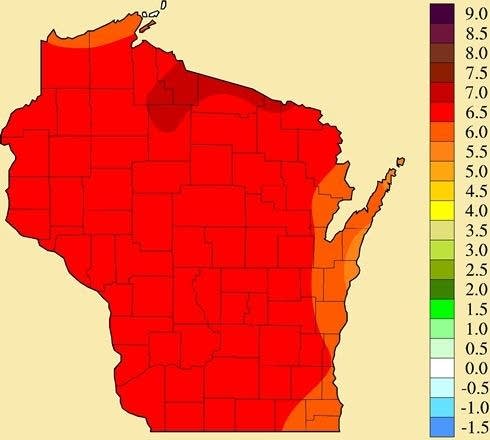UW Madison Climate Study: Biggest warming near Minnesota?

[image]
Wisconsin Initiative on Climate Change Impacts (WICCI) study projects average annual temperatures in Wisconsin will rise 4 to 9 degrees Fahrenheit by 2055.
A new climate change study released last week by the Wisconsin Initiative on Climate Change Impacts (WICCI) group at the University of Wisconsin-Madison should catch the eye of Minnesotans. According to the study, the biggest impacts from climate change may occur during the winter season in northwest Wisconsin near the Twin Cities.
That's just one of the conclusions of the study, which was run on supercomputers using 14 different global climate models. The study is raising eyebrows in Wisconsin; where it is being used by various state agencies to plan ways to adapt to climate change.
Create a More Connected Minnesota
MPR News is your trusted resource for the news you need. With your support, MPR News brings accessible, courageous journalism and authentic conversation to everyone - free of paywalls and barriers. Your gift makes a difference.
Among the study's findings:
Observed historical data:
-Average annual temperatures in Wisconsin have increased +1.1°F, with a peak warming of 2-2.5°F across northwest Wisconsin, closest to Minnesota.
-Observed warming since 1950 has been greatest in winter, with an average increase of 2.5°F across Wisconsin. Winter temperatures in northwest Wisconsin (near Minnesota) have increased by 3.5-4.5°F.
[image]
Observed warming since 1950.
-Wisconsin as a whole has become wetter, with an increase in annual precipitation of 3.1 inches. This observed increase in annual precipitation has primarily occurred in southern and western Wisconsin.
Future climate projections:
-Average annual temperatures in Wisconsin will increase 4 to 9 degrees by 2055. That's four times the already observed increase since 1950.
-The warming is projected to be largest in winter, with projected increases of 5-11°F by the mid-21st century across Wisconsin, with the greatest warming across northwest Wisconsin (again, near the Twin Cities and Minnesota).
[image]
Projected warming in the winter season.
-Typically, daily high temperatures exceed 90°F roughly 12 times per year in southern Wisconsin and only 5 times per year in northern Wisconsin. Based on one emission scenario, by the mid-21st century, the frequency of such hot days may double to about 25 times per year in the south and triple to about 12 times per year in the north. This consists of 1.5 to 4 more weeks each year with daily high temperatures exceeding 90°F.
Near the Twin Cities, the average annual number of 90 degree days could reach 20.
This peer reviewed study is largely consistent with the IPCC reports on climate change and the effects on the Upper Midwest. Some of the projected effects are already being observed in the landscape around Minnesota.
If the study's finding verify and winters are as much as 8 degrees warmer in the Twin Cities, that could have huge effects on the amount of snow cover we would see and be able to maintain during the winter. We could also see increased fire and disease activity in our forests and a transition from forest to prairie in the Twin Cities area and to the north.
This will study no doubt raise some eyebrows in Minnesota as well as Wisconsin. Milder winters have both positive and negative effects. The most striking prediction to me is the rate of predicted temperature changes in the next 45 years compared to the past 50 years.
Stay tuned.
PH